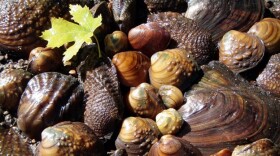I think everyone will agree that we had a long winter. We didn’t get the weeks of minus 30 degrees like last year, but winter did hang around a long time. The ice finally went off Tomahawk Lake last Friday on May 6th, a full month after the 2021 ice out date. Walking across the yard yesterday at Kemp Station, I saw that my friends are back - miner bees. Miner bees or sometimes called digger bees include several species of solitary ground nesting bees. Imagine an ant hill with an extra-large pencil-sized hole in the middle. These nests pepper our yard every spring. Let’s talk about miner bees and why they are important.
Wisconsin has dozens of insects that are classified as bees. Of course, we can all picture the honeybee and box hives scattered across the state. We have other familiar bees including the sweat bee, bumble bee, squash bee, and miner bee. Interestingly, most bees are solitary.
Bees, wasps, and hornets are all part of the same order – hymenoptera. That is a large order including other groups of insects such as ants. One major difference between bees, wasps, and hornets is that, in general, bees can only sting you one time whereas a wasp or hornet can sting multiple times. A bee’s stinger is barbed so it stays embedded in your flesh tearing away from the bee, bringing with it an untimely death.
Miner bees rarely sting. We often think of honeybees, which can be aggressive because they have a hive to defend and honey to protect. Solitary bees have everything to lose if they sting a human or animal because it means certain death for them. If the mother bee dies before her young have matured, her lineage ends. It is common to see miner bees circling around solitary bee nests. These are likely to be males, which can’t sting. So miner bees pose little risk. Many species are very tiny — smaller than a grain of rice — and therefore too small to sting. If they are able to sting, their venom is too weak to do much damage.
Don’t confuse solitary ground nesting bees with colonies of ground nesting wasps. Ground nesting wasps often build their nests in rodent burrows, live in colonies with dozens to hundreds of wasps, and are very aggressive. Many of us have encountered these angry devils while mowing the lawn. You are unaware that you mowed over their nest, but quickly become aware when the stinging starts followed by your mad dash to safety.

Much of the soil on Kemp Station is very sandy. This is why it is so attractive to miner bees – easy . The nest are easy to see early in the spring, because the grass is still brown, thin, and matted from the winter.
A solitary ground nest is a tube about 6 inches long, often with a series of side tunnels that function as brood chambers. Sand and soil particles accumulate around the entrance hole forming a mound called a tumulus. These nests are excavated into the ground by a female bee. There are many dangers associated with building nests into the ground. Examples include predators, moisture and flooding (which is reduced in sandy soils), nest disturbance (by people, vehicles, other large animals), and pesticides. To deal with the natural threats that ground nesting bees face, they've developed many strategies to protect their young. Bees line their nests with things like hard-packed soil, bits of cut leaves and masticated flower petals. One genus of ground nesting bee is known as "cellophane bees" for the clear, waterproof material they paint onto the walls of their nests. Whatever the material, nest linings keep the young sufficiently dry and retain the integrity of the nest.
A key benefit of miner bees is they are pollinators. We have raspberries and apple trees on Kemp Station, so pollination is crucial for successful fruit crops. Of course, many other native plants depend upon pollination to reproduce.
Many people take pride in their green thumbs and produce beautiful gardens, flower beds, and lawns. Think twice about what pesticides you use, don’t use more than you need, don’t use it in places you don’t need it, and be careful of our pollinators during applications. It's important to note that miner bees are not much of a threat to your lawn. You can continue to mow your lawn and play fetch with your dog right next to the bees. Enjoy the promise of summer and enjoy the natural world around you.









